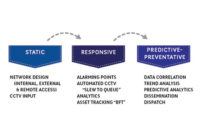By 2040, nearly two-thirds (65 percent) of the world’s population will call metropolitan areas home. This rapid urbanization places even greater strain on government agencies and infrastructures to remain agile and maintain public order – and potentially do so without the added resources to match community growth.
Today’s citizens demand more from their local leaders. They want assurance that their officials can deliver basic livability essentials while keeping their families and property secure. To accommodate these needs, more city managers, county commissioners and elected representatives are turning to data-driven technologies that can better address public safety, communications and transportation challenges, among others.
During this urban evolution, it can be challenging for decision-makers to understand how to translate greater visibility into actionable results. As the three scenarios below exemplify, intelligent cities can make more informed decisions, deploy resources more efficiently and position themselves as safe, thriving and attractive destinations by linking versatile technologies with citizens’ greatest needs.
Streamlined Traffic Flow
During the daily commute, drivers often find themselves sitting for minutes at a traffic light on a major thoroughfare while the cross street goes untraveled. Beyond the aggravation and backup, this rigid, cyclical light alternation increases accident potential, as drivers either speed through yellow lights or become frustrated and unfocused.
As a result, more cities are installing automated, intelligent light management to better account for shifting traffic volumes. City officials then can review camera and radar data to gauge flow, volume and backup at priority intersections and adjust light systems for various dayparts and seasons. The results thus far are encouraging – article from Apolitical discussing Pittsburgh travel times uncovered that wait times have fallen by up to 40 percent at Pittsburgh intersections featuring AI-powered light technology.
Automated traffic systems also can reduce congestion through real-time notification. These same connected cameras and radar sensors feed traffic trends into a centralized database, which aggregates and transmits information to drivers’ phones and navigation devices. Drivers in turn can avoid crowded streets and reduce the volume at slow-moving intersections.
Analytics-Based Crime Reduction
The most effective way to combat crime is to prevent it from happening. While it’s unreasonable to expect a complete elimination of illegal activity, new data-rich platforms highlight behavioral trends that police can leverage to reduce the impact and volume of crime.
Although the concept of predictive policing is not new, its relevance has expanded alongside emerging connected technologies. While basic predictive platforms cannot pinpoint suspects, they can detect patterns that enable more strategic patrol. In addition, police can review and analyze geographic crime data to anticipate possible times and locations for future incidents. For instance, if data indicates that burglaries occur most frequently on Wednesday afternoons in a given city, police can better allocate resources for that window to be present and engaged with the community in an effort to prevent the crime, and subsequent victimization, from ever occurring.
Complementary intelligence-led policing technologies take analytics further by spotlighting potential suspects and victims. In highlighting individuals’ criminal histories, connections to other inmates or suspects and offense frequency and location, intelligent databases empower police and probation officers to first attempt remediation over incarceration. Through proactive conversation, local law enforcement can alert high-risk individuals to potential criminal consequences, stop retaliatory crime and work to reform likely repeat offenders.
Fast, Risk-Free Emergency Response
In times of crisis when their property, or potentially their lives, are in danger, citizens trust that their local emergency response teams can reach them without delay. More civic officials are adopting mobile platforms and computer-aided dispatch (CAD) to eliminate the inefficiencies and possible time loss associated with legacy manual processes.
CAD-based communications leverage a central command center to activate available response teams immediately after dispatchers log an incident. If the first contacted agency is unavailable, the system will work through a pre-established roster to find a ready nearby team rather than requiring first responders to search for and input contact information. First responders can also communicate with response teams through connected apps for more immediate, delay-free notification.
Along with protecting citizens, data-based response technologies can safeguard police and EMS teams from on-site risks. Emergency dispatchers can review and alert field officials to potential dangers, such as crime scene escalation, in real-time. Officers can also receive valuable details about unfamiliar locations to guide their approach. A notification that hazardous materials are present, for example, can deter the firing of weapons. Readiness plans can provide evacuation zones and exits that have been prepared ahead of time rather than on-the-spot during a high-stress emergency situation.
By implementing forward-facing and detail-rich platforms, city agencies can take proactive measures to work more efficiently, make responsible resource decisions and ultimately boost community safety. This initiative can inspire residents to feel the same loyalty for their city that they do for their favorite brands, and enable all parties to promote a location as a favorable destination for individuals and companies to inhabit.



